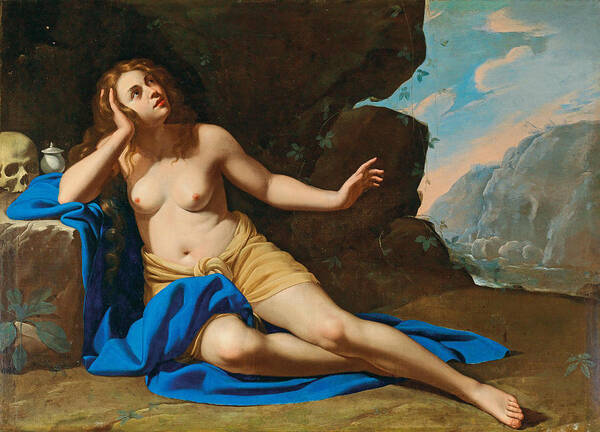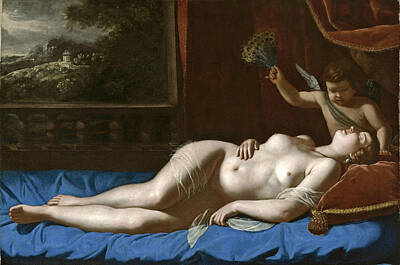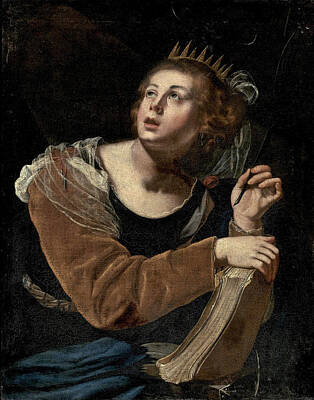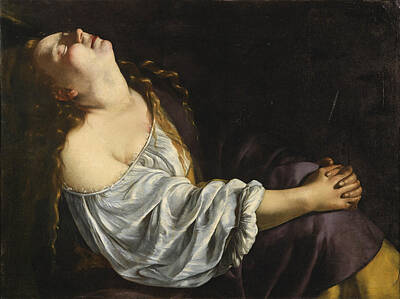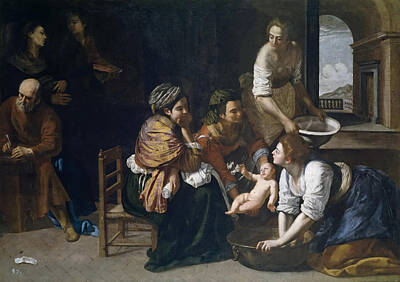Artemisia Gentileschi
Penitent Magdalene
The Birth Of St John The Baptist
Fine Art Prints | Greeting Cards | Phone Cases | Lifestyle | Face Masks | Men's , Women' Apparel | Home Decor | jigsaw puzzles | Notebooks | Tapestries | ...
Artemisia Gentileschi (Italian pronunciation: [arteˈmizja dʒentiˈleski]; July 8, 1593 – c. 1656) was an Italian Baroque painter, today considered one of the most accomplished painters in the generation following that of Caravaggio. In an era when women painters were not easily accepted by the artistic community or patrons, she was the first woman to become a member of the Accademia di Arte del Disegno in Florence.[1]
She painted many pictures of strong and suffering women from myth and the Bible – victims, suicides, warriors.[2]
Her best-known work is Judith Slaying Holofernes (a well-known medieval and baroque subject in art), which "shows the decapitation of Holofernes, a scene of horrific struggle and blood-letting".[3] That she was a woman painting in the seventeenth century and that she was raped and participated in prosecuting the rapist, long overshadowed her achievements as an artist. For many years she was regarded as a curiosity. Today she is regarded as one of the most progressive and expressionist painters of her generation.
Biography
Roman beginning
Susanna and the Elders, her first work 1610 – Schönborn Collection, Pommersfelden
Artemisia Gentileschi was born in Rome on 8 July 1593, although her birth certificate from the Archivio di Stato indicated she was born in 1590, the eldest child of the Tuscan painter Orazio Gentileschi and Prudentia Montone.[4] Artemisia was introduced to painting in her father's workshop, showing much more talent than her brothers, who worked alongside her. She learned drawing, how to mix color, and how to paint. Since her father's style took inspiration from Caravaggio during that period, her style was just as heavily influenced in turn. Her approach to subject matter was different from her father's, however, as her paintings are highly naturalistic, where Orazio's are idealized. At the same time, Artemisia had to resist the "traditional attitude and psychological submission to this brainwashing and jealousy of her obvious talent" (Bissell, 113). By doing so, she gained great respect and recognition for her work.[5]
The first work of the young seventeen-year-old Artemisia was the Susanna e i Vecchioni (Susanna and the Elders) (1610, Schönborn collection in Pommersfelden). At the time some, influenced by the prevailing misconceptions, suspected that she was helped by her father. The painting shows how Artemisia assimilated the realism of Caravaggio without being indifferent to the language of the Bologna school, which had Annibale Carracci among its major artists. It is one of the few paintings on the theme of Susanna showing the sexual accosting by the two Elders as a traumatic event.
In 1611, her father was working with Agostino Tassi to decorate the vaults of Casino della Rose inside the Pallavicini Rospigliosi Palace in Rome, so Orazio hired the painter to tutor his daughter privately. During this tutelage, Tassi raped Artemisia. Another man, Cosimo Quorlis, was also involved. After the initial rape, Artemisia continued to have sexual relations with Tassi, with the expectation that they were going to be married and with the hope to restore her dignity and her future. Tassi reneged on his promise to marry Artemisia. Nine months after the rape, when he learnt that Artemisia and Tassi were not going to be married, Orazio pressed charges against Tassi.[6] Orazio also claimed that Tassi stole a painting of Judith from the Gentileschi household. The major issue of this trial was the fact that Tassi had taken Artemisia's virginity. If Artemisia had not been a virgin before Tassi raped her, the Gentileschis would not have been able to press charges. During the ensuing seven-month trial, it was discovered that Tassi had planned to murder his wife, had engaged in adultery with his sister-in-law, and planned to steal some of Orazio’s paintings. During the trial, Artemisia was subjected to a gynecological examination and torture using thumbscrews to verify her testimony. At the end of the trial Tassi was sentenced to imprisonment for one year, although he never served the time. The trial influenced the feminist view of Artemisia Gentileschi during the late twentieth century.
Artemisia was surrounded mainly by the presence of males since the loss of her mother at age 12. When Artemisia was 17, Orazio rented the upstairs apartment of their home to a female tenant, Tuzia. Artemisia befriended Tuzia; however, Tuzia allowed Agostino Tassi and Cosimo Quorlis to accompany Artemisia in Artemisia's home on multiple occasions. The day the rape occurred, Artemisia cried for the help of Tuzia, but Tuzia simply ignored Artemisia and pretended she knew nothing of what happened. Artemisia felt betrayed by Tuzia, and because Tuzia was the only female figure in her life, Artemisia's works contained a strong sense of the importance of solidarity and unity between women.
The painting, Giuditta che decapita Oloferne (Judith beheading Holofernes) (1612–1613), displayed in the Capodimonte Museum of Naples, is striking for the violence portrayed. A month later, Orazio arranged for his daughter to marry Pierantonio Stiattesi, a modest artist from Florence. Shortly afterward the couple moved to Florence, where Artemisia received a commission for a painting at Casa Buonarroti. She became a successful court painter, enjoying the patronage of the Medici family and Charles I. It has been proposed that during this period Artemisia also painted the Madonna col Bambino (The Virgin and Child), currently in the Spada Gallery, Rome.
While in Florence, Artemisia and Pierantonio had a daughter around 1618, Prudentia, but who was also known as Palmira, which has led some scholars to conclude erroneously that Artemisia had two children, not one.[7] Prudentia was named after Artemisia's mother who died when Artemisia was 12. It is noteworthy that her daughter was a painter, trained by her mother, although nothing is known of her work.[8]
Florentine period (1614–1620)
Self-Portrait as a Lute Player, 1615–1617
Judith Slaying Holofernes (1614–20) Oil on canvas 199 x 162 cm Galleria degli Uffizi, Florence
In Florence, Artemisia enjoyed huge success. She was the first woman accepted into the Accademia delle Arti del Disegno (Academy of the Arts of Drawing). She maintained good relations with the most respected artists of her time, such as Cristofano Allori, and was able to garner the favours and the protection of influential people, starting with Granduke Cosimo II de' Medici and especially, of the Granduchess Cristina. She had a good relationship with Galileo Galilei, with whom she corresponded by letter for a long time.
She was esteemed by Michelangelo Buonarroti the younger (nephew of the great Michelangelo): busy with construction of Casa Buonarroti to celebrate his notable relative, he asked Artemisia to produce a painting to decorate the ceiling of the gallery of paintings. The painting represents an allegory of Allegoria dell'Inclinazione, "Allegory of the Inclination (natural talent)", presented in the form of a nude young woman holding a compass. It is believed that the subject bears a resemblance to Artemisia. Indeed, in several of her paintings, Artemisia's energetic heroines resemble her self-portraits.
Her success and gender fueled many rumors about her private life. For example, some speculate that the case of her rape released her from societal pressures, having created an understanding of why some of her works were filled with defiant and violent women,[9] rather than examining the style of those influencing hers. Notable works from this period include La Conversione della Maddalena (The Conversion of the Magdalene), Self-Portrait as a Lute Player (in the collection of the Wadsworth Atheneum Museum of Art) and Giuditta con la sua ancella (Judith and her Maidservant), now in the Pitti Palace. Artemisia painted a second version of Giuditta che decapita Oloferne (Judith beheading Holofernes), this one larger than the Naples version, which now is housed in the Uffizi Gallery of Florence. Despite her success, financial excesses borne by her for her husband led to problems with creditors, and she fell out with her husband. She returned without him to Rome in 1621.
Return to Rome, Venice period (1621–1630)
Artemisia arrived in Rome the same year her father Orazio departed for Genoa. While there is not enough evidence for this, some believe that Artemisia followed her father to Genoa, asserting that this time together would have accentuated the similarity of their styles, making it often difficult to determine which of the two painted certain works. Most of the evidence, however, supports the notion that Artemisia remained in Rome, trying to find a home and raise her child.
Although the master had been dead over a decade, Caravaggio's style was still highly influential and converted many painters to following his style (the so-called Caravaggisti), such as Artemisia's father Orazio, Carlo Saraceni (who returned to Venice 1620), Bartolomeo Manfredi, and Simon Vouet. Painting styles in Rome during the early seventeenth century were diverse, however, demonstrating a more classic manner of the Bolognese disciples of the Carracci and the baroque style of Pietro da Cortona.
It appears that Artemisia also was associated the Academy of the Desiosi. She was celebrated with a portrait carrying the inscription "Pincturare miraculum invidendum facilius quam imitandum". During the same period she became friends with Cassiano dal Pozzo, a humanist and a collector and lover of arts.
Despite her artistic reputation, her strong personality, and her numerous good relationships, however, Rome was not so lucrative as she hoped. Her style, tone of defiance, and strength relaxed. She painted less intense works; for instance, her second version of Susanna and the Elders (1622).[9] The appreciation of her art was narrowed down to portraits and to her ability with biblical heroines. She did not receive any of the lucrative commissions for altarpieces. The absence of sufficient documentation makes it difficult to follow Artemisia's movements in this period. It is certain that between 1627 and as late as 1630, she moved to Venice, perhaps in search of richer commissions. Evidence for this is that verses and letters were composed in appreciation of her and her works in Venice.
Although it is sometimes difficult to date her paintings, it is possible to assign certain works by her to these years, the Ritratto di gonfaloniere (Portrait of Gonfaloniere), today in Bologna (a rare example of her capacity as portrait painter) and the Giuditta con la sua ancella, (Judith and her Maidservant) today housed at the Detroit Institute of Arts. The Detroit painting is notable for her mastery of chiaroscuro and tenebrism (the effects of extreme lights and darks), techniques for which Gerrit van Honthorst, Trophime Bigot, and many others in Rome were famous. Her Venere Dormiente (The Sleeping Venus), today at Virginia Museum of Fine Arts, Richmond, and her Ester ed Assuero (Esther and Ahasuerus) located at the Metropolitan Museum of Art in Manhattan, are testimony to her assimilation of the lessons of Venetian luminism.
Naples and the English period (1630–1653)
In 1630 Artemisia moved to Naples, a city rich with workshops and art lovers, in search of new and more lucrative job opportunities. Many other artists, including Caravaggio, Annibale Carracci, and Simon Vouet had stayed in Naples for some time in their lives. At that time, Jusepe de Ribera, Massimo Stanzione, and Domenichino were working there, and later, Giovanni Lanfranco and many others would flock to the city. The Neapolitan debut of Artemisia is represented by the Annunciation in the Capodimonte Museum. She remained in Naples for the remainder of her career with the exceptions of a brief trip to London and some other journeys.
Naples was for Artemisia a kind of second homeland; her daughter was married there. On Saturday, 18 March 1634, the traveller Bullen Reymes records in his diary visiting Artemisia and Palmira ('who also paints') with a group of fellow-Englishmen.[10] She received letters of appreciation, being in good relations with the viceroy, the Duke of Alcalá, and started relations with many renowned artists, among them Massimo Stanzione, with whom, the eighteenth-century writer Bernardo de' Dominici reports, she started an artistic collaboration based on a real friendship and artistic similarities.
In Naples for the first time Artemisia started working on paintings in a cathedral, dedicated to San Gennaro nell'anfiteatro di Pozzuoli (Saint Januarius in the amphitheater of Pozzuoli) in Pozzuoli. During her first Neapolitan period she painted Nascita di San Giovanni Battista (Birth of Saint John the Baptist) located in the Museo del Prado in Madrid, and Corisca e il satiro (Corisca and the satyr), in a private collection. In these paintings Artemisia again demonstrates her ability to adapt to the novelties of the period and handle different subjects, instead of the usual Judith, Susanna, Bathsheba, and Penitent Magdalenes, for which she already was known.
In 1638 Artemisia joined her father in London at the court of Charles I of England, where Orazio became court painter and received the important job of decorating a ceiling (allegory of Trionfo della pace e delle Arti (Triumph of Peace and the Arts) in the Queen's House, Casa delle Delizie of Queen Henrietta Maria of France in Greenwich). Father and daughter were working together once again, although helping her father probably was not her only reason for travelling to London: Charles I had invited her to his court, and it was not possible to refuse. Charles I was a fanatical collector, willing to ruin public finances to follow his artistic wishes. The fame of Artemisia probably intrigued him, and it is not a coincidence that his collection included a painting of great suggestion, the Autoritratto in veste di Pittura ("Self-Portrait as the Allegory of Painting"), which is the lead image of this article.
Orazio died suddenly in 1639. Artemisia had her own commissions to fulfill after her father's death, although there are no known works assignable with certainty to this period. It is known that Artemisia had already left England by 1642, when the civil war was just starting. Nothing much is known about her subsequent movements. Historians know that in 1649 she was in Naples again, corresponding with Don Antonio Ruffo of Sicily, who became her mentor during this second Neapolitan period. The last known letter to her mentor is dated 1650 and makes clear that she still was fully active.
Sleeping Venus
As Artemisia grew older, her work became more graceful and "feminine," and while this was to some extent part of the general shift in taste and sensibility, it must also have resulted from the artist becoming more and more self-consciously a woman painter (Garrard 136-37).
Artemisia was once thought to have died in 1652/1653;[3] however, recent evidence has shown that she was still accepting commissions in 1654, although she was increasingly dependent upon her assistant, Onofrio Palumbo.
Some have speculated that she died in the devastating plague that swept Naples in 1656 and virtually wiped out an entire generation of Neapolitan artists.
Some works in this period are, Susanna e i vecchioni (Susanna and the elders) today in Brno, Madonna e Bambino con rosario (Virgin and Child with a Rosary) today in El Escorial, David and Bathsheba today in Columbus, Ohio, Museum of Art, and Bathsheba today in Leipzig.
Historical artistic importance
Judith and her Maidservant (1613–14) Oil on canvas Palazzo Pitti, Florence
A research paper by Roberto Longhi, an important Italian critic, dated 1916, named Gentileschi padre e figlia (Gentileschi, father and daughter) described Artemisia as "the only woman in Italy who ever knew about painting, coloring, doughing, and other fundamentals". Longhi also wrote of Judith Slaying Holofernes: "There are about fifty-seven works by Artemisia Gentileschi and 94% (forty-nine works) feature women as protagonists or equal to men" (Bissell, 112). These include her works of Jael and Sisera, Judith (Judith and her Maidservant), and Esther. These characters intentionally lacked the stereotypical 'feminine' traits—sensitivity, timidness, and weakness—and were courageous, rebellious, and powerful personalities (Bissell, 112-3). A nineteenth-century personality commented on Artemisia's Magdalene stating, "no one would have imagined that it was the work of a woman. The brush work was bold and certain, and there was no sign of timidness" (Bissell, 112). In Bissell's view, she was well aware of how women and female artists were viewed by men, therefore explaining why her works in the beginning of her career were so bold and defiant(Bissell, 113).[11]
It was said, "Who could think in fact that over a sheet so candid, a so brutal and terrible massacre could happen [...] but—it's natural to say—this is a terrible woman! A woman painted all this? ... there's nothing sadistic here, instead what strikes the most is the impassibility of the painter, who was even able to notice how the blood, spurting with violence, can decorate with two drops the central spurt! Incredible I tell you! And also please give Mrs. Schiattesi—the conjugal name of Artemisia—the chance to choose the hilt of the sword! At last don't you think that the only aim of Giuditta is to move away to avoid the blood which could stain her dress? We think anyway that that is a dress of Casa Gentileschi, the finest wardrobe in the Europe during 1600, after Van Dyck."
Feminist studies increased the interest toward Artemisia's artistic work and life. Such studies underlined her suffering of rape and subsequent mistreatment, and the expressive strength of her paintings of biblical heroines, in which the women are interpreted as willing to manifest their rebellion against their condition. In a research paper from the catalogue of the exhibition "Orazio e Artemisia Gentileschi" which took place in Rome in 2001 (and after in New York), Judith W. Mann critiques feminist opinion of Artemisia, finding that old stereotypes of Artemisia as sexually immoral have been replaced by new stereotypes established in feminist readings of Artemisia's paintings:
An opinion like that presupposes that the full creative potential of Artemisia is only about strong capable women, at the point that seems impossible to imagine her busy doing conventional religious images, like a Virgin Mary with a Baby or a virgin submissively waiting for the Annunciation; and besides it is said that the artist refused to modify her personal interpretation of those subjects to conform to the preferences of a client base presumably composed by males. The stereotype caused a double restrictive effect: it both induced the critics to doubt about the attribution of the paintings not corresponding to described model, and to give an inferior value to the ones not found on the cliché.
Because Artemisia returned again and again to violent subject matter such as Judith and Holofernes, a repressed-vengeance theory has been postulated. Some art historians suggest however, that she was shrewdly taking advantage of her fame from the rape trial to cater to a niche market in sexually charged, female-dominant art for male patrons.
The most recent critic, starting from the difficult reconstruction of the entire catalogue of the Gentileschi, tried to give a less reductive reading of the career of Artemisia, placing it more accurately in the context of the different artistic environments in which the painter actively participated. A reading such as this restores Artemisia as an artist who fought with determination—using the weapon of personality and of the artistic qualities—against the prejudices expressed against women painters; being able to introduce herself productively in the circle of the most respected painters of her time, embracing a series of pictorial genres that probably were more ample and varied than her paintings suggest.
Artemisia and contemporary female painters
Mary Magdalene
For a woman at the beginning of the seventeenth century, Artemisia being a painter represented an uncommon and difficult choice, but not an exceptional one. Before Artemisia, between the end of the 1500 and the beginning of 1600 other women painters had successful careers, including Sofonisba Anguissola (Born in Cremona around 1530, Palermo around 1625), was called into Spain by King Philip II and Lavinia Fontana (Bologna, 1552, Rome 1614) departed for Rome by invitation of Pope Clement VIII. Later Fede Galizia (Milano or Trento, 1578, Milano 1630) painted still lifes and a Judith with the head of Holofernes.
Other women painters began their career while Artemisia was alive. Judged on their artistic merits, Longhi's statement that Artemisia was "the only woman in Italy who ever knew about painting" may be questioned, but there is no doubt that Artemisia continues to be among the most highly regarded of women artists, and she has attained her place among the great artists of the Baroque.
Artemisia in other works
The first writer who produced a novel around the figure of Artemisia might be George Eliot in Romola (1862–1863), where some aspects of Gentileschi's story, while set in Florence in Gentileschi's time, are recognizable, but much embroidered. A later and more clear use of Gentileschi's story is by Anna Banti, wife of Roberto Longhi. Her first draft of the manuscript, dated 1944, was lost during the war. Three years later she started again with the book, to be entitled, Artemisia, writing in a much different form. Banti's book is written in an "open diary" form, in which she maintains a dialogue with Artemisia, trying to understand why she finds her so fascinating.
Gentileschi is one of the women represented in The Dinner Party, an installation artwork by Judy Chicago that was first exhibited in 1979.
Gentileschi's life and the Judith Slaying Holofernes painting played a pivotal role in the 1997 miniseries, Painted Lady, starring Helen Mirren.
Artemisia, and more specifically her painting Judith Beheading Holofernes, are referred to in Wendy Wasserstein's 1988 play, The Heidi Chronicles, where the main character, Heidi, lectures about it as part of her art history course on female painters. At the end of the play, Heidi adopts a daughter she names Judy, which is at least a partial reference to the painting. Canadian playwright Sally Clark wrote several stage plays based on the events leading up to and following the rape of Artemisia. "Life Without Instruction" was commissioned by Nightwood Theatre in 1988, and was developed during an Ontario Arts Council Playwright's Residency in 1989. It was work-shopped in 1990, under the direction of Kate Lushington and drama-turged by Jackie Maxwell. "Life Without Instruction" premiered at Theatre Plus Toronto on August 2, 1991.
The film, Artemisia (1997), by Agnès Merlet is inspired by the painter.
The French writer Alexandra Lapierre became fascinated by Artemisia and wrote a novel about her, derived from scrupulous study of the painter and the historical context of her work. The novel seeks to understand the relationship between Artemisia the woman and Artemisia the painter, and ends with describing as "leitmotiv" the relationship between her and her father, composed of both love insufficiently expressed, and a latent professional rivalry. Artemesia: A Novel (1998) was translated and published in the United States in 2000, and is faithful to her life. It was listed as nonfiction in its original European publication.
In 2002, Susan Vreeland's The Passion of Artemisia (a novel loosely based on her life) was published by Penguin.
She appears in Eric Flint's Ring of Fire alternate history, being mentioned in 1634: The Galileo Affair and figuring prominently in 1635: The Dreeson Incident
2015 saw the world premiere of "Blood/Water/Paint," a semi-biographical play about Gentileschi, written by Joy McCullough-Carranza.
Full list of works by Artemisia Gentileschi
References
Gunnell, Barbara (4 July 1993). "The rape of Artemisia". The Independent. Archived from the original on 28 December 2014. Retrieved 28 December 2014.
"great-works/gentileschi-artemisia-judith-and-her-maidservant". www.independent.co.uk. Retrieved 2015.
Lubbock, Tom (30 September 2005). "Great Works: Judith and her Maidservant". The Independent (London). p. 30, Review section.
Bissell, R. Ward (1999). Artemisia Gentileschi and the Authority of Art: Critical Reading and Catalogue Raisonné. University Park, PA: The Pennsylvania University Press. p. 135.
Bissell, Ward R. Artemisia Gentileschi and the Authority of Art: Critical Reading and Catalogue Raisonne. University Park: The Pennsylvania State University Press,1999.
Cohen, Elizabeth. The Trials of Artemisia Gentileschi: A Rape as History. The Sixteenth Century Journal. pp. 47–75.
Bisell, R. Ward (1999). Artemisia Gentileschi and the Authority of Art: Critical Reading and Catalogue Raisonné. University Park, PA: The Pennsylvania University Press. p. 159.
Garrard, Mary D. Artemisia Gentileschi: The Image of the Female Hero in Italian Baroque Art. New Jersey: Princeton University Press, 1989. p. 63
"Gentileschi Father and Daughter". The Oxford Companion of Western Art Ed. 2001. Oxford Reference Online Premium. 25 Oct 2011.[1]
Edward Chaney, The Evolution of the Grand Tour: Anglo-Italian Cultural Relations since the Renaissance 2nd ed. (Routledge, 2000), p. 111.
Bissell, Ward R. Artemisia Gentileschi and the Authority of Art: Critical Reading and Catalogue Raisonne. University Park: The Pennsylvania State University Press,1999. Online.[2]
Further reading
Barker, Sheila (December 2014). "A new document concerning Artemisia Gentileschi’s marriage". The Burlington Magazine. Vol. 156 no. 1341. pp. 803–804.
Bissell, R. Ward (1999). Artemisia Gentileschi and the Authority of Art. Penn State Press. ISBN 0-271-02120-9.
Christiansen, Keith (2004). "Becoming Artemisia: Afterthoughts on the Gentileschi Exhibition". Metropolitan Museum Journal 39: 101–126.
Contini, Roberto; Solinas, Francesco (2011). Artemisia Gentileschi: storia di una passione (in Italian). Palazzo reale di Milano, Milano: 24 ore cultura.
Contini, Roberto; Solinas, Francesco (2013). Artemisia: la musa Clio e gli anni napoletani (in Italian). Roma, De Luca: Blu palazzo d'arte e cultura (Pisa).
Garrard, Mary D. (2001). Artemisia Gentileschi around 1622: The Shaping and Reshaping of an Artistic Identity. University of California Press. ISBN 978-0520228412.
Garrard, Mary D. (1991). Artemisia Gentileschi. Princeton University Press.
Lapierre, Alexandra (2001). Artemisia: The Story of a Battle for Greatness. Vintage. ISBN 0-09-928939-3.
Christiansen, Keith; Mann, Judith W. (2001). "Orazio and Artemisia Gentileschi". New Haven and London: Exh. cat., Metropolitan Museum of Art.
Locker, Jesse M. (2015). Artemisia Gentileschi: The Language of Painting. New Haven, Yale University Press. ISBN 9780300185119.
Lutz, Dagmar (2011). Artemisia Gentileschi: Leben und Werk (in German). Belser, Stuttgart, Germany. ISBN 978-3-7630-2586-2.
Judith Mann, ed. (2006). Artemisia Gentileschi: Taking Stock. Brepols Publishers. ISBN 978-2503515076.
Rabb, Theodore K. (1993). Renaissance Lives: Portraits of an Age. New York: Pantheon Books.
Solinas, Francesco; Nicolaci, Michele; Primarosa, Yuri (2011). Lettere di Artemisia: edizione critica e annotata con quarantatre documenti inediti (in Italian). Roma, De Luca.
Straussman-Pflanzer, Eve (2013). Violence & virtue: Artemisia Gentileschi's Judith slaying Holofernes. Chicago: The Art Institute of Chicago.
Vreeland, Susan (2002). "The Passion of Artemisia". Headline Review. ISBN 0-7472-6533-X.
External links
The Life and Art of Artemisia Gentileschi
Artemisia, The Rape and the Trial
Paintings by Gentileschi
Artist
A - B - C - D - E - F - G - H - I - J - K - L - M -
N - O - P - Q - R - S - T - U - V - W - X - Y - Z
Retrieved from "http://en.wikipedia.org/"
All text is available under the terms of the GNU Free Documentation License



